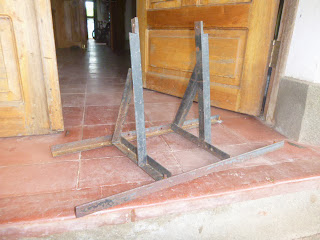Deliverable: Submit welding request
Today our mission was twofold- improve our adjustment mechanism and submit our welding request. We want to have a welded model by next Monday.
As a reminder, this is our "working" prototype from last class:
Absolutely stunning.
We started the class by brainstorming ideas to change our adjustment mechanism:
This design was having leg posts in different places. One option would be having a pair on either side of the bottom bars; another option would be having one pair of leg posts in the middle
This design would have only two leg posts, instead of two pairs of two leg posts. These legs would swivel on the screws.
Alex's design also incorporates a rotating leg post. She also drew pictures of a man with one central leg, and also a baby.
We talked to Machine Shop Larry and got his opinion. He suggested that we put the leg posts on the outside of the trapezoid, instead of the inside.
We decided on our final design, which is to have one leg per side that swings around on a bolt, and also has a slit in the middle of each leg to be run through a screw that is secured on the other side. We decided to eliminate the top bar of the trapezoid, and put the chainstay supports directly on the two side bars, which turns our design from a trapezoid into a triangle. I know that doesn't quite make sense, but you'll see the pictures soon enough.
Pictured: our new triangle (not trapezoid) frame.
We chose not to cut new pieces of metal for our welded design. Instead, we disassembled the parts from our working model. For our second welded model (if we have time) we'll cut new parts of metal.
In order to get a clean welding line, we filed down the edges of our side bars in order to get an angle that can be attached to the bottom and top bars:
Debbie used a protractor to determine the angles that we needed to shave off.
We shaved off some bits of both sides of the side bars.
We drilled holes through the sides of the side bars for the adjustment mechanism, and away we went. We submitted a request to Machine Shop Larry to weld our design.
These are the pieces of metal that will be used in our bike stand. It's not much, considering the bulk of our last approximately six designs.
A final write-up of our design, including lengths of the pieces.
Since this week is Thanksgiving week, today (Monday) is the only class period we have this week. Next Monday (12/2) we'll be waiting to see if our design got welded, and the Monday after that (12/9) our final model and project write-up is due.
Happy Thanksgiving!









































.JPG)
.JPG)


.JPG)



